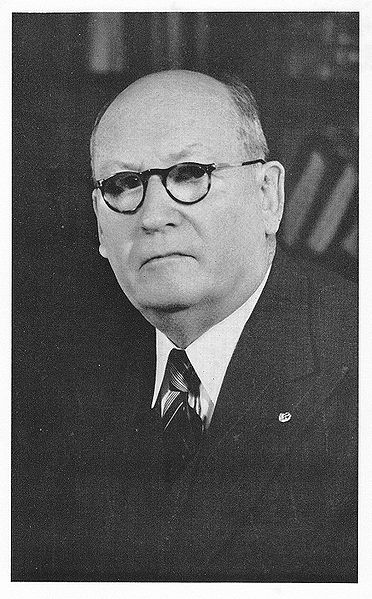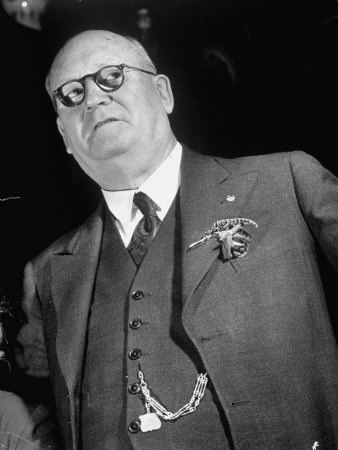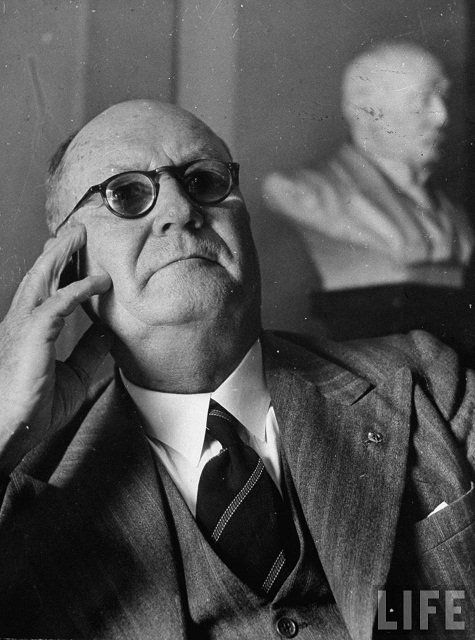<Back to Index>
- Astrophysicist Thomas Gold, 1920
- Poet Gérard de Nerval, 1808
- 5th Prime Minister of South Africa Daniel François Malan, 1874
PAGE SPONSOR



Dr. Daniel François Malan (22 May 1874 – 7 February 1959), more commonly known as D.F. Malan, was the Prime Minister of South Africa from 1948 to 1954. He is seen as the champion of Afrikaner nationalism. His National Party government came to power on the program of apartheid and began the comprehensive implementation of the segregationist policy.
Malan was born in Riebeek - Wes in the Cape Colony. He obtained a B.A. in Mathematics and Science from the Victoria College in Stellenbosch, whereafter he entered the Stellenbosch seminary in order to train as a minister in the Dutch Reformed Church. Along with his studies in theology, he obtained a M.A. in Philosophy from Victoria College, later to be Paul Roos Gymnasium and the Stellenbosch University. Malan left South Africa in 1900 to study towards a Doctorate in Divinity at the University of Utrecht, which he obtained in 1905. After his return to South Africa, he was ordained as a minister of the Dutch Reformed Church and served for six months as an assistant minister in Heidelberg, Transvaal. He was an ardent fighter for the acceptance of Afrikaans, which was an emerging language fighting against Dutch and English, and was a founding member of the Afrikaanse Taal en Kultuur Vereeniging (ATKV) (Afrikaans language and cultural society), which was established in 1906. He was stationed in Montagu from 1906 to 1912 and thereafter in Graaff - Reinet until 1915. He also undertook a journey on behalf of the Dutch Reformed Church, visiting Afrikaners in the Belgian Congo and Southern Rhodesia.
The Union of South Africa came into being on 31 May 1910 , eight years after the end of the Second Boer War, with Louis Botha as the first prime minister. In 1912, J.B.M. Hertzog broke his ties with Botha and formed the National Party in 1914. In those years, every party had newspapers affiliated to it, which acted as its mouthpiece. However, Nationalist minded Afrikaners in the Cape had no such mouthpiece and therefore, in 1915, decided to found De Burger, later known as Die Burger. They persuaded Malan to become the editor of the new newspaper and, as he was worried about the Afrikaners' political position in the aftermath of the 1914 Rebellion, he accepted the position, thus relinquishing his position as a minister in the Dutch Reformed Church. A Cape branch of Hertzog's National Party was founded in 1915 and Malan was elected as its provincial leader. Malan was elected to Parliament in 1918.
The National Party came to power under the leadership of Hertzog in 1924, and Malan was given the post of Minister of the Interior, Education and Public Health, which he held until 1933. In 1925, Malan was at the forefront of a campaign to replace Dutch with Afrikaans in the constitution as well as to provide South Africa with its own national flag.
In 1934, the United Party was formed out of the merger between Hertzog's National Party and the rival South African Party of Jan Smuts. Malan strongly opposed the merger; he and 19 other MPs defected to form the 'Purified' National Party in 1935, which he led for the next thirteen years as opposition. Malan also opposed South African participation in World War II, which was already unpopular among the Afrikaner population and led to a split in the governing party; this dramatically increased his popularity, and he consequently defeated Smuts and the United Party in 1948.
After coming to power and leading for six and a half years, a firm foundation for apartheid was laid. The system was officially dismantled in 1994, but the legacy continues to have an impact in South Africa. Malan retired in 1954 at the age of 80, but in the succession battle that accompanied his retirement, his anointed heirs, N.C. Havenga and E. Donges were defeated and Malan was thus succeeded by J.G. Strijdom.
He died in 1959 at Môrewag, his home in Stellenbosch. His book, Afrikaner Volkseenheid en my ervaringe op die pad daarheen ("Afrikaner Nationalism and my experiences on the road to it"), was published in the same year by Nasionale Boekhandel. A collection of his writings and documents is housed in the Document Centre at the University of Stellenbosch's J.S. Gericke library.
He is positioned 81st on the SABC3's Great South Africans list.
The progenitor of the Malan name in the South African region was a French Huguenot refugee named Jacques Malan from Provence (Mérindol), France, who arrived at the Cape before 1689. The Malan name is one of a number of Afrikaans names of French origin which have retained their original spelling.
In 1952 J B L Smith was told about a coelacanth that had just been landed by fishermen at Anjouan and recognised by an adventurer called Eric Hunt. He had persuaded them that the fish was worth a lot of money and shouldn't be sold to anyone other than the South African government. This would be only the second specimen known to science. The first specimen identified by Marjorie Courtenay - Latimer was preserved only as a skin, so Smith needed to collect this new specimen and get it refrigerated quickly so that the internal organs wouldn't decay. His local MP, Vernon Shearer, telephoned Malan and together with Smith persuaded him to send the South African Air Force to fetch the fish and bring it back to South Africa. Because second specimen differed from the first one in two key ways, it lacked the first dorsal fin and its tail fin was truncated, Smith named the fish in honour of Malan and the place where the fish was caught, Malania anjouanae. Eventually it was established that this wasn't a different species at all, and exactly the same fish as the first specimen, Latimeria chalumnae; the apparent differences were down to a shark attack that cost the fish one of its dorsal fins and part of its tail.